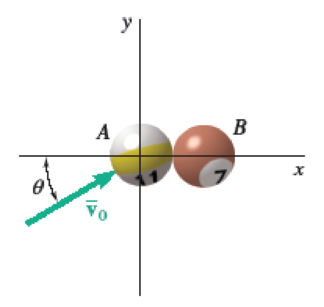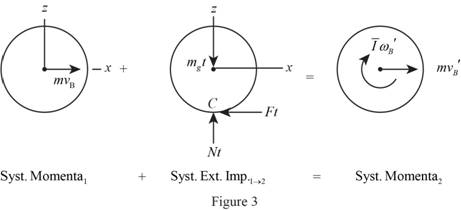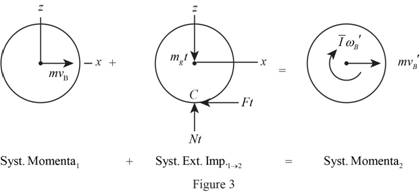
Concept explainers
In a game of pool, ball A is rolling without slipping with a velocity

Fig. P17.133
a)
The linear and angular velocity of each ball immediately after the impact.
Answer to Problem 17.133P
The linear velocity of ball A immediately after the impact is
The angular velocity of ball A immediately after the impact is
The linear velocity of ball B immediately after the impact is
The angular velocity of ball B immediately after the impact is
Explanation of Solution
Given information:
The mass of the each ball is m.
The radius of the each ball is r.
The velocity of the ball A before the impact is
The coefficient of kinetic friction between a ball and the table
Calculation:
Write the equation of moment of inertia
Analyze the impact of ball A.
Here, G is the mass center of ball A.
Consider the conservation of momentum principle.
Sketch the impulse and momentum diagram of the ball A as shown in Figure 1.

Here,
Refer Figure (1).
Consider the kinematics in position 1.
Write the equation of angular velocity
Consider the horizontal components of forces.
Consider the vertical components of forces.
Take moments about y axis.
Take moments about x axis.
Analyze the impact of ball B.
Here, G is the mass center of ball B.
Consider the conservation of momentum principle.
Sketch the impulse and momentum diagram of the ball B as shown in Figure (2).

Here,
Refer Figure (2),
Consider the horizontal components of forces.
Consider the vertical components of forces.
Take moments about y axis.
Take moments about x axis.
Add Equations (1) and (5).
The impact is perfectly plastic. Therefore ,the coefficient of restitution (e) is 1.
Consider the condition of impact equation.
Substitute 1 for e.
Find the horizontal components of linear velocity
Solve Equations (9) and (10) simultaneously.
Add Equations (9) and (10).
Find the horizontal components linear velocity
Substitute
Find the vertical components of linear velocity
Find the vertical components of linear velocity
Find the linear velocity
Substitute 0 for
Thus, the linear velocity of ball A immediately after the impact is
Find the linear velocity
Substitute
Thus, the linear velocity of ball B immediately after the impact is
Find the initial angular velocity of ball A using kinematics.
Find the angular velocity
Solve Equations (3) and (4) simultaneously.
Add Equations (3) and (4).
Substitute
Thus, the angular velocity of ball A immediately after the impact is
Find the angular velocity
From Equations (7) and (8).
Thus, the angular velocity of ball B immediately after the impact is
b)
Find the velocity of ball B after it has started rolling uniformly.
Answer to Problem 17.133P
The velocity of ball B after it has started rolling uniformly is
Explanation of Solution
Calculation:
Consider the motion after impact of ball B.
Consider C is the mass center of ball A.
Consider the conservation of momentum principle.
Sketch the motion of impulse and momentum diagram of the ball A after the impact as shown in Figure (3).

Here,
Consider the condition of rolling without slipping in kinematics.
Refer Figure (3).
Take moments about C:
Substitute
Find the velocity of sphere A after it has started rolling uniformly using the equation:
Substitute
Thus, the velocity of ball A after it has started rolling uniformly is
Consider the motion after impact of ball A.
Consider C is the mass center of ball A.
Consider the conservation of momentum principle.
Sketch the motion of impulse and momentum diagram of the ball B after the impact as shown in Figure (3).

Here, N is the normal force on ball A, F is the friction force between ball and floor, t is the rolling time,
Consider the condition of rolling without slipping in kinematics.
Refer Figure (3),
Take moments about C:
Substitute
Find the velocity of sphere B after it has started rolling uniformly using the equation:
Substitute
Thus, the velocity of sphere B after it has started rolling uniformly is
Want to see more full solutions like this?
Chapter 17 Solutions
VECTOR MECH...,STAT.+DYNA.(LL)-W/ACCESS
Additional Engineering Textbook Solutions
Automotive Technology: Principles, Diagnosis, And Service (6th Edition) (halderman Automotive Series)
Starting Out with C++: Early Objects (9th Edition)
Management Information Systems: Managing The Digital Firm (16th Edition)
Vector Mechanics For Engineers
Starting Out with Java: From Control Structures through Objects (7th Edition) (What's New in Computer Science)
Starting Out with Python (4th Edition)
- Sketch and explain a PV Diagram and a Temperature Entropy Diagram for a 4 stroke diesel engine please, please explain into detail the difference bewteen the two and referance the a diagram. Please include a sketch or an image of each diagramarrow_forwardDraw left view of the first orthographic projectionarrow_forwardSketch and Describe a timing diagram for a 2 stroke diesel engine emphasis on the 2 stroke as my last answer explained 4 stroke please include a diagram or sketch.arrow_forward
- A 4 ft 200 Ib 1000 Ib.ft C 2 ft 350 Ib - за в 2.5 ft 150 Ib 250 Ib 375 300 Ib Replace the force system acting on the frame. shown in the figure by a resultant force (magnitude and direction), and specify where its line of action intersects member (AB), measured from point (A).arrow_forwardA continuous flow calorimeter was used to obtain the calorific value of a sample of fuel and the following data collected: Mass of fuel: 2.25 kgInlet water temperature: 11 ° COutlet water temperature 60 ° CQuantity of water: 360 Liters Calorimeter efficiency: 85%Calculate the calorific value of the sample ( kJ / kg ). ive submitted this question twice and have gotten two way different answers. looking for some help thanksarrow_forward15 kg of steel ball bearings at 100 ° C is immersed in 25 kg of water at 20 ° C . Assuming no loss of heat to or from the container, calculate the final temperature of the water after equilibrium has been attained.Specific heat of steel: 0.4857 kJ / kg / ° KSpecific heat of water: 4.187 kJ / kg / ° Karrow_forward
- Sketch and explain a PV Diagram and a Temperature Entropy Diagram for a 4 stroke diesel enginearrow_forwardA continuous flow calorimeter was used to obtain the calorific value of a sample of fuel and the following data collected: Mass of fuel: 2.25 kgInlet water temperature: 11 ° COutlet water temperature 60 ° CQuantity of water: 360 Liters Calorimeter efficiency: 85%Calculate the calorific value of the sample ( kJ / kg ).arrow_forwardChapter 12 - Lecture Notes.pptx: (MAE 272-01) (SP25) DY... Scoresarrow_forwardmylabmastering.pearson.com Chapter 12 - Lecture Notes.pptx: (MAE 272-01) (SP25) DY... P Pearson MyLab and Mastering Scoresarrow_forwardanswer the fallowing Brake Specific Fuel Consumption - 0.3 kg/kwh, Mechanical Efficiency- 90% Calorific Value of Fuel -45 MJ/kg. Given these values, find the indicated power, indicated thermal efficiency and brake thermal efficiencyarrow_forwardProblem 6. The circular plate shown rotates about its vertical diameter. At the instant shown, the angular velocity ₁ of the plate is 10 rad/s and is decreasing at the rate of 25 rad/s². The disk lies in the XY plane and Point D of strap CD moves upward. The relative speed u of Point D of strap CD is 1.5 m/s and is decreasing at the rate of 3 m/s². Determine (a) the velocity of D, (b) the acceleration of D. Answers: =0.75 +1.299]-1.732k m/s a=-28.6 +3.03-10.67k m/s² 200 mm x Zarrow_forwardarrow_back_iosSEE MORE QUESTIONSarrow_forward_iosRecommended textbooks for you
 Elements Of ElectromagneticsMechanical EngineeringISBN:9780190698614Author:Sadiku, Matthew N. O.Publisher:Oxford University Press
Elements Of ElectromagneticsMechanical EngineeringISBN:9780190698614Author:Sadiku, Matthew N. O.Publisher:Oxford University Press Mechanics of Materials (10th Edition)Mechanical EngineeringISBN:9780134319650Author:Russell C. HibbelerPublisher:PEARSON
Mechanics of Materials (10th Edition)Mechanical EngineeringISBN:9780134319650Author:Russell C. HibbelerPublisher:PEARSON Thermodynamics: An Engineering ApproachMechanical EngineeringISBN:9781259822674Author:Yunus A. Cengel Dr., Michael A. BolesPublisher:McGraw-Hill Education
Thermodynamics: An Engineering ApproachMechanical EngineeringISBN:9781259822674Author:Yunus A. Cengel Dr., Michael A. BolesPublisher:McGraw-Hill Education Control Systems EngineeringMechanical EngineeringISBN:9781118170519Author:Norman S. NisePublisher:WILEY
Control Systems EngineeringMechanical EngineeringISBN:9781118170519Author:Norman S. NisePublisher:WILEY Mechanics of Materials (MindTap Course List)Mechanical EngineeringISBN:9781337093347Author:Barry J. Goodno, James M. GerePublisher:Cengage Learning
Mechanics of Materials (MindTap Course List)Mechanical EngineeringISBN:9781337093347Author:Barry J. Goodno, James M. GerePublisher:Cengage Learning Engineering Mechanics: StaticsMechanical EngineeringISBN:9781118807330Author:James L. Meriam, L. G. Kraige, J. N. BoltonPublisher:WILEY
Engineering Mechanics: StaticsMechanical EngineeringISBN:9781118807330Author:James L. Meriam, L. G. Kraige, J. N. BoltonPublisher:WILEY
 Elements Of ElectromagneticsMechanical EngineeringISBN:9780190698614Author:Sadiku, Matthew N. O.Publisher:Oxford University Press
Elements Of ElectromagneticsMechanical EngineeringISBN:9780190698614Author:Sadiku, Matthew N. O.Publisher:Oxford University Press Mechanics of Materials (10th Edition)Mechanical EngineeringISBN:9780134319650Author:Russell C. HibbelerPublisher:PEARSON
Mechanics of Materials (10th Edition)Mechanical EngineeringISBN:9780134319650Author:Russell C. HibbelerPublisher:PEARSON Thermodynamics: An Engineering ApproachMechanical EngineeringISBN:9781259822674Author:Yunus A. Cengel Dr., Michael A. BolesPublisher:McGraw-Hill Education
Thermodynamics: An Engineering ApproachMechanical EngineeringISBN:9781259822674Author:Yunus A. Cengel Dr., Michael A. BolesPublisher:McGraw-Hill Education Control Systems EngineeringMechanical EngineeringISBN:9781118170519Author:Norman S. NisePublisher:WILEY
Control Systems EngineeringMechanical EngineeringISBN:9781118170519Author:Norman S. NisePublisher:WILEY Mechanics of Materials (MindTap Course List)Mechanical EngineeringISBN:9781337093347Author:Barry J. Goodno, James M. GerePublisher:Cengage Learning
Mechanics of Materials (MindTap Course List)Mechanical EngineeringISBN:9781337093347Author:Barry J. Goodno, James M. GerePublisher:Cengage Learning Engineering Mechanics: StaticsMechanical EngineeringISBN:9781118807330Author:James L. Meriam, L. G. Kraige, J. N. BoltonPublisher:WILEY
Engineering Mechanics: StaticsMechanical EngineeringISBN:9781118807330Author:James L. Meriam, L. G. Kraige, J. N. BoltonPublisher:WILEY